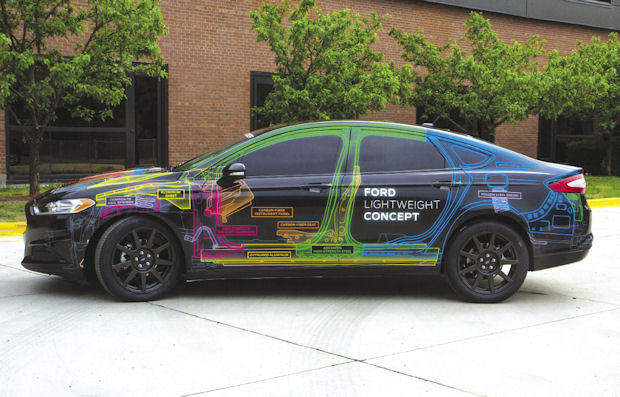
Ford’s Lightweight Concept vehicle reduces the weight of a 2013 Fusion to that of a Ford Fiesta—nearly a 25% weight reduction. Image courtesy of Ford Motor Co.
Latest News
October 1, 2014
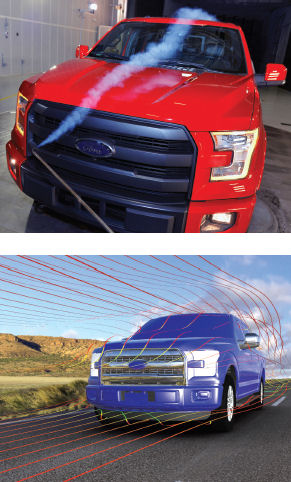 The 2015 Ford F150 undergoing wind tunnel testing and aerodynamic simulation. Images courtesy of Ford Motor Co.
The 2015 Ford F150 undergoing wind tunnel testing and aerodynamic simulation. Images courtesy of Ford Motor Co.In the ongoing race to lightweight vehicles and meet more rigorous emissions standards, Ford Motor Co. is out-lapping some of the competition with a pair of high-profile programs intended to advance new materials and manufacturing processes from experimental pilots into high-volume production.
Ford’s redesigned 2015 F-150 is due to hit dealer showrooms later this year. It makes liberal use of aluminum throughout the body of the popular full-size pickup, in addition to a new high-strength steel chassis. Together, the innovations drive a dramatic weight loss of up to 700 lbs.
In addition to this effort, Ford is also showing off a Lightweight Concept vehicle. It slashes the weight of a 2013 Fusion to that of a Ford Fiesta—a nearly 25% reduction.
Matt Zaluzec, Ford’s senior technical leader for global materials and manufacturing research and a technical advisory board member, notes that lightweighting has always been part of Ford’s overall project portfolio to meet government regulations and the Corporate Average Fuel Economy (CAFE) targets set by the U.S. Environmental Protection Agency (EPA).
“As these targets get more challenging, we will continue to refine powertrains to get incremental improvements,” he notes. “But lightweighting becomes the big push now.”
Like most automotive giants, Ford has stepped up its lightweighting efforts in response to more rigorous government fuel economy mandates. In 2012, the Obama administration put new CAFE standards in place that upped the 29.7 mpg mandate to 35.5 mpg by 2016, and to 54.5 mpg by 2025.
Alternative powertrain systems, like those on electric and hybrid vehicles, have been widely touted as a way for automakers to meet the new government regulations. However, lightweighting, through the introduction of new materials like aluminum or composites, or by consolidating components and reducing the amount of materials used, is factoring more prominently into automakers’ development strategies. Lightweighting also helps manufacturers create balance as additional systems and components are added to new car models to address users’ continuing desire for more bells and whistles, from entertainment systems to air bag safety systems.
“The move to alternative powertrain systems has contributed to the emphasis on lightweighting because of the need to offset the added weight of heavy battery packs and electric vehicle/hybrid electric vehicle components and systems,” notes Scott Fallon, general manager, automotive at SABIC’s Innovative Plastics business, which designed an advanced polycarbonate (PC) glazing solution for the rear window on Ford’s Lightweight Concept vehicle. “OEMs are also trying to offset the weight of other content that is being added to vehicles like safety and infotainment systems.”
 Ford’s Lightweight Concept vehicle reduces the weight of a 2013 Fusion to that of a Ford Fiesta—nearly a 25% weight reduction. Image courtesy of Ford Motor Co.
Ford’s Lightweight Concept vehicle reduces the weight of a 2013 Fusion to that of a Ford Fiesta—nearly a 25% weight reduction. Image courtesy of Ford Motor Co.A Combination Approach
With the 2015 F-150 and the Lightweight Concept vehicle, Ford is promoting a holistic, multi-materials strategy that identifies opportunities across the entire vehicle to eliminate weight. “Our goal is to use the right materials in the right location at the right time,” Zaluzec explains. “It’s a combination of materials and process.”
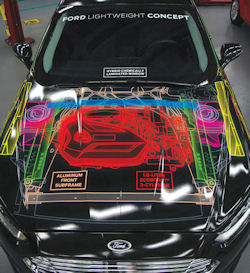 An aluminum front subframe and a chemically laminated windshield are just some of the innovations in Ford’s Lightweight Concept vehicle. Image courtesy of Ford Motor Co.
An aluminum front subframe and a chemically laminated windshield are just some of the innovations in Ford’s Lightweight Concept vehicle. Image courtesy of Ford Motor Co.In addition to deploying stamped aluminum across 95% of the F-150’s body, the new pickup features a high-strength steel frame, which serves as the backbone of the vehicle. It also makes it 60 lbs. lighter than previous models, according to Ford officials. Replacing the long-proven welded steel construction of the F-150 with lightweight aluminum requires more than an investment in new materials, however. It also requires Ford to investigate next-generation manufacturing processes that can support the production of the aluminum-based truck in high-volume quantities.
“We have been stamping steel for over 100 years, and stamping aluminum for a better part of 25 years,” Zaluzec says. “But we have to think beyond stamping to next-generation processes like hydroforming, extruding aluminum, and compression molding of carbon fibers. We have to develop these new manufacturing enablers while simultaneously advancing our engineering and advanced materials development.”
Changing manufacturing processes, perfecting new joining strategies, and exploring how to best leverage lightweight materials doesn’t come without risk, notes Dave Mason, senior VP, Global Automotive, at Altair, a maker of simulation software. Companies like Ford are making aggressive use of advanced simulation and optimization software in their design processes to minimize that risk; they’re helping to expand opportunities for use of lightweight materials and identify potential areas for material removal, he explains, adding: “Ford is doing everything we talk about.”
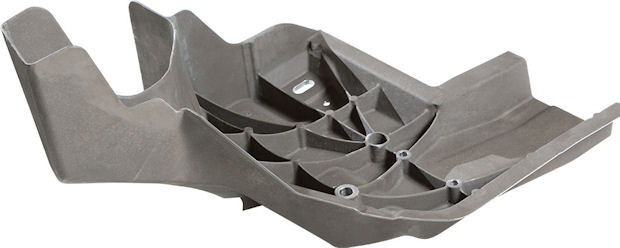 The kickdown casting used in the Ford Lightweight Concept vehicle reduces weight by incorporating many stampings in the foot pedal region of the body in white structure. Image courtesy of Cosma International/Magna International.
The kickdown casting used in the Ford Lightweight Concept vehicle reduces weight by incorporating many stampings in the foot pedal region of the body in white structure. Image courtesy of Cosma International/Magna International.The 2015 F-150 is a huge step forward in terms of lightweighting success. But Ford’s Lightweight Concept Car showcases ongoing research in mixed material applications that can be produced in large volumes across the Ford vehicle lineup, while still remaining affordable for consumers. The research vehicle was developed as part of the U.S. Department of Energy’s Vehicle Technologies Program, an initiative led by automotive supplier Magna International in cooperation with Ford and other partners to utilize commercially available and demonstrated materials and manufacturing processes to produce a lightweight vehicle.
Magna took the lead on the body structure, closures and chassis, and Ford was responsible for the weight-optimized powertrain, suspension and interior for the concept vehicle—in addition to spearheading validation and testing of the materials and manufacturing processes. Beyond the extensive use of aluminum, the Lightweight Concept vehicle employs strategically placed carbon fiber and magnesium throughout its construction, as well as other advanced materials used in the windows and interior features.
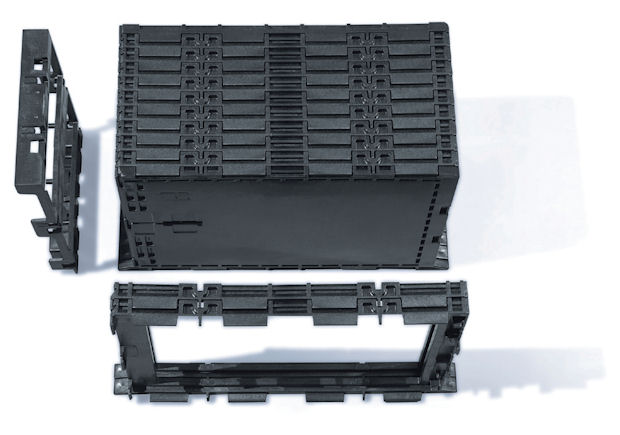 In addition to technology found in the Ford concept vehicle, SABIC’s NORYL GFN resin is used to help lightweight the Ford Focus Electric’s high-voltage battery pack. Image courtesy of SABIC.
In addition to technology found in the Ford concept vehicle, SABIC’s NORYL GFN resin is used to help lightweight the Ford Focus Electric’s high-voltage battery pack. Image courtesy of SABIC.While the use of multi-materials and the corresponding manufacturing processes has been tapped for other vehicle programs, they have only been produced in limited quantities, not in high volume. So says Jeff Conklin, department manager at Cosma International, the division of Magna working with Ford on the Lightweight Concept vehicle.
“That’s the biggest challenge here: designing a product that can be built with the processes and products out there today in the industry,” Conklin says. “We had to make sure the body in white design could be incorporated in the Ford assembly line, and be assembled in high volume. It couldn’t be any hand-applied stuff. This is all robotically done.”
The use of multi-materials throughout the vehicle presented a whole new set of production considerations, Zaluzec admits.
“You’re not just bringing in steel or aluminum into a plant, you’re bringing steel and aluminum in—and they don’t join the same way,” he explains. “There’s a lot of assembly technology required to put together mixed materials.”
New joining technologies, specifically those that address galvanic corrosion issues, were part of what Cosma brought to the development effort, Conklin says. The division also adapted its aluminum pressure vacuum die casting process for the project, which Conklin notes was essential in reducing the material thickness of the aluminum compared to traditional casting processes.
SABIC’s Innovation Plastics business was another key collaborator on the Lightweight Concept vehicle, responsible for supplying a PC glazing solution that facilitated a 35% weight reduction in the rear window (compared to the same window on a 2013 Ford Fusion production model). The weight savings comes from the lower density of the material, about half that of glass, which is made possible by its ability to be injection molded, says SABIC’s Fallon.
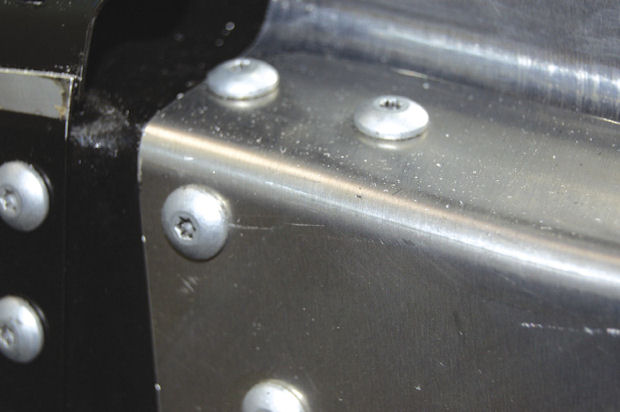 The joints used in the Lightweight Concept vehicle had to be redesigned to support high-volume vehicle production. Image courtesy of Cosma International/Magna International.
The joints used in the Lightweight Concept vehicle had to be redesigned to support high-volume vehicle production. Image courtesy of Cosma International/Magna International.“This opens the door to many new design opportunities that glass can not achieve,” he explains. “PC allows designers to cost-effectively integrate features that simplify assembly. In addition, integration opportunities made possible through injection molding can mean fewer parts or materials, which can mean less weight.”
Beyond weight savings, Fallon says PC glazing offers manufacturers additional advantages in that designs can go beyond the shape and complexity limitations of glass to geometric effects that can result in relatively thin PC surfaces.
“You can create aerodynamic components that minimize drag and reduce fuel demand,” Fallon says. “This is significant, because for every 10% increase in aerodynamic efficiency, an increase in fuel economy of 1% to 2% can be achieved.”
Having a fundamental understanding of the properties of the materials, along with the manufacturing processes, is critical given there’s a balancing act to be mastered—offsetting the costs of the new technologies with part consolidation.
“There’s a play when moving from material A to material B with an opportunity to consolidate parts,” Zaluzec says. “It becomes a very important part of the design DNA.”
More Info
Subscribe to our FREE magazine, FREE email newsletters or both!
Latest News
About the Author
Beth Stackpole is a contributing editor to Digital Engineering. Send e-mail about this article to [email protected].
Follow DE





